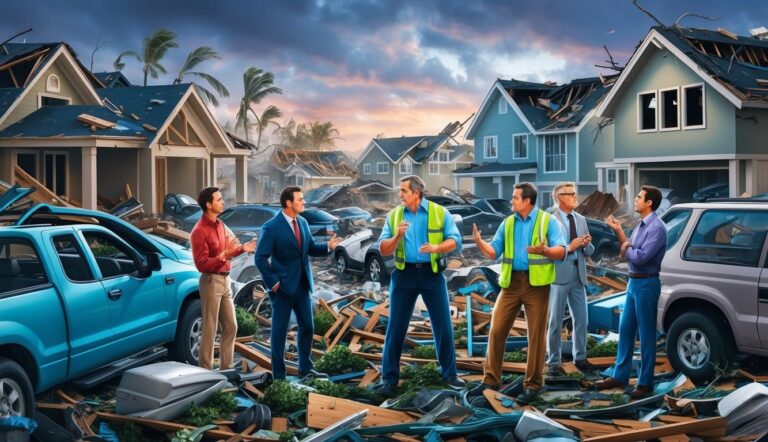Understanding Catastrophe-Related Insurance Claims
Navigating catastrophe-related insurance claims requires a clear understanding of the types of catastrophes, the role of insurance adjusters, and the claim filing process.
Each aspect plays a vital role in ensuring you are adequately covered and compensated.
Types of Catastrophes and Insurance Coverage
Catastrophes can be classified into various types, including natural disasters such as hurricanes, earthquakes, floods, and wildfires.
Each type may be covered differently under insurance policies.
Your policy might include specific endorsements to cover business interruption, which compensates for lost income during repairs.
It is crucial to review your commercial property insurance to identify what is specifically covered.
Understanding your coverage limits, deductibles, and exclusions is essential.
For instance, some policies may not cover flood damage unless specified, requiring additional coverage.
Knowing these details can significantly impact your financial protection.
The Role of Insurance Adjusters in Catastrophes
Insurance adjusters play a critical role in assessing claims resulting from catastrophic events.
They evaluate the extent of the damage, review documentation, and determine the validity of your claim.
During this process, adjusters gather essential information such as photographic evidence and repair estimates.
Their findings are crucial for insurance companies in deciding the compensation you receive.
Independent adjusters often work during major disasters to expedite claims processing.
Familiarizing yourself with their role can help you understand the steps involved and how to communicate effectively with them for a smoother claims experience.
Claim Filing Process for Catastrophic Events
Filing a claim for a catastrophic event involves a series of steps designed to document your losses accurately.
First, you must contact your insurance provider as soon as possible to report the damage.
Provide detailed information, including dates, descriptions of the loss, and any relevant documentation.
Keep records of all communications with your insurance company and adjusters.
Consider creating a comprehensive list of damaged property and their estimated values.
This will support your claim and help verify your losses.
Being thorough in the documentation process can streamline the claims process and enhance the likelihood of a favorable outcome.
Challenges and Dispute Resolution in Catastrophic Claims

In catastrophic claims, navigating the intricacies of property damage and business interruption can prove challenging.
Disputes arise frequently, and understanding the resolution processes is crucial for ensuring fair settlements.
Navigating Disputes over Property Damage Claims
Property damage claims commonly lead to disputes due to differing assessments of damage severity and repair costs.
Insurers and policyholders may disagree on the extent of coverage and the valuation of losses.
You should document all damage thoroughly, including photographs and receipts.
Clear communication with your insurer can help clarify expectations and detail the basis for claims.
If disputes arise, a discussion with your claims adjuster often resolves misunderstandings.
If resolution is not achieved, formal processes may be necessary.
Engaging in mediation can provide a neutral ground for both parties to reach an agreement.
If mediation fails, arbitration may follow, offering a binding result that avoids lengthy litigation.
Business Interruption Claims and Disputes
Business interruption claims present unique challenges.
You often need to demonstrate lost revenue due to an insured event.
The calculations may involve complex financial records and projections for future earnings.
Disputes frequently arise over the period of interruption and the accuracy of claimed losses.
Ensure that your documentation is thorough, including financial statements and records of ongoing expenses.
Communication with your insurer is vital during this process.
Clarify the terms of your policy related to the duration and scope of coverage.
In cases where negotiations stall, consider seeking assistance from professionals with experience in business interruption claims.
Appraisal, Mediation, and Arbitration Processes
Appraisal is a valuable tool for resolving disputes about the value of property damage.
Both parties appoint independent appraisers to assess damages objectively.
If they cannot agree, an umpire may be involved to render a decision.
Mediation serves as another option for dispute resolution.
It facilitates a negotiated agreement with the assistance of a neutral mediator.
This process can be less adversarial and is often quicker than litigation.
If mediation is unsuccessful, arbitration may provide a binding resolution.
In this case, an arbitrator reviews the evidence presented and makes a final decision.
This process can be more efficient than going to court and usually results in quicker claim settlements.
Legal Aspects and Litigation in Insurance Disputes

Navigating the legal aspects of insurance disputes is essential, especially in the wake of catastrophes.
Understanding the implications of litigation, the roles of public adjusters and attorneys, and strategies for securing a fair settlement can empower you as a policyholder.
Understanding the Litigation Landscape
The litigation process in insurance disputes often begins when claims are denied or underpaid by your insurance provider.
Key stages include pleadings, discovery, and trial, where evidence is gathered, and arguments are presented.
Federal and state laws also play a significant role.
Depending on jurisdiction, certain statutes may dictate how insurance claims must be handled, including timelines for filing and responding to claims.
This legal framework is critical as it determines the possible outcomes and strategies you can use in your case.
The Role of Public Adjusters and Attorneys
Public adjusters serve as advocates for policyholders during a claim process.
They help in documenting losses, negotiating with insurance companies, and ensuring that your claim is fully supported.
Unlike insurance adjusters, who represent the interests of the insurance company, public adjusters focus solely on your interests.
Attorneys specializing in insurance law can provide additional legal expertise.
They navigate complex policy language and legal jargon to identify potential discrepancies that could enhance your claim.
Collaborating with both public adjusters and attorneys can significantly improve your chances of securing a favorable settlement, especially in challenging circumstances.
Strategies for Achieving a Fair Settlement
To achieve a fair settlement in your insurance dispute, several strategies can be employed.
First, gather comprehensive documentation of your losses, including photographs, receipts, and witness statements.
This will strengthen your claim.
Secondly, be aware of the timelines and follow the necessary procedures when filing your claim.
Delays can weaken your position.
Thirdly, consider professional representation early in the process.
Engaging public adjusters and legal counsel can help balance the power dynamic between you and the insurance companies.
Lastly, be prepared to negotiate.
Understand your policy’s terms and be open to counteroffers from the insurance provider.
Knowing when to compromise and when to stand firm is key to achieving a fair outcome in your claim settlement.
Case Studies: Handling Claim Disputes in Major Catastrophes

Navigating claim disputes during major catastrophes requires a thorough understanding of specific circumstances and unique challenges.
The complexity of damages from hurricanes, wildfires, floods, and earthquakes can significantly affect the claims process and recovery for affected parties.
Assessing Claims after Hurricanes and Storms
In the wake of hurricanes and storms, you face the challenge of accurately assessing extensive damage.
Insurers often deploy teams of insurance adjusters to evaluate properties swiftly.
This assessment includes determining structural damage, evaluating wind-related losses, and identifying secondary issues such as mold.
To facilitate claims, documentation is crucial.
Keep a detailed record of all damage with photos and written descriptions.
This evidence supports your case in any disputes that arise with your insurance company over coverage limits or exclusions.
Wildfire Damage Claims and Adjustments
Wildfires present unique challenges in the claims process.
When dealing with wildfire damage, insurance adjusters must account for a wide range of losses, including structural damage, smoke damage, and loss of personal property.
Insurance policies often include specific exclusions for certain types of damage.
Understanding your policy’s terms helps you prepare for potential disputes.
You may need to negotiate with your insurer if they undervalue your losses or deny claims based on such exclusions.
Documenting all communications and retaining copies of your insurance claim submission is essential.
Flood-Related Claim Issues and Solutions
Flood-related claims can escalate quickly, especially in cases where insurance policies have specific flood exclusions.
When natural disasters occur, insurance companies often see a surge of claims, which can lead to backlogs and delays in processing.
You must know the National Flood Insurance Program (NFIP) guidelines, as many homeowners have flood coverage through this program.
Timely submission of claims and maintaining clear communication with your adjuster can mitigate disputes.
It’s also beneficial to compile a thorough inventory of affected possessions and document damages in detail to support your claim.
Earthquake Insurance Claims Handling
Earthquake claims can involve complexities distinct from other disasters.
Many standard homeowners’ insurance policies exclude earthquake damage, which means that you may need a specific earthquake insurance policy to cover such losses.
If you have earthquake coverage, understanding the terms, conditions, and deductibles is vital.
Adjusters will evaluate both structural and personal property damage.
Challenges can arise if there’s a dispute over the severity of the damage or the costs involved in repairs.
Keeping records of repairs and maintaining open lines of communication with your insurance provider will help expedite the process and resolve claims effectively.
Best Practices for Insurers and Policyholders in Catastrophe Claims

In the context of catastrophe claims, both insurers and policyholders must adopt effective strategies to facilitate smoother claims processing and resolution.
Proper documentation, clear communication, and risk management are essential components for navigating complex claims arising from natural disasters.
Documentation and Evidence Collection
Accurate documentation is critical for substantiating your claim.
Start by gathering all relevant information, including:
- Photographs of damaged property, including before and after images.
- Receipts for repairs and temporary housing to prove incurred expenses.
- Expert assessments from contractors or inspectors, detailing the extent of damage.
Organizing this information systematically can bolster your case during the claims process.
Keep digital copies of everything and track communications with your insurance provider.
A well-documented claim not only strengthens your position but also speeds up the review process.
You should also maintain a detailed log of events, including dates and descriptions, to assist your adjuster and prevent disputes.
Effective Communication with Insurance Providers
Clear and effective communication with your insurer is essential.
Ensure you understand your policy’s terms and conditions, especially regarding coverage limits and exclusions.
When communicating with your provider:
- Be concise: Clearly state your needs and provide relevant documentation.
- Ask questions: Don’t hesitate to clarify terms or processes you find confusing.
- Follow up: After submitting a claim or documentation, regularly check the status to prevent delays.
Approach every interaction professionally.
Keeping a record of all exchanges (emails, calls, meetings) can also help avoid misunderstandings.
Your insurer is more likely to address your claim efficiently if you maintain an open line of communication.
Risk Management and Mitigation Strategies
Implementing effective risk management practices can minimize the impact of catastrophes on your property.
Consider the following strategies:
- Property assessments: Regularly evaluate your property for vulnerabilities and undertake preventive measures, such as reinforcing structures against storms.
- Maintaining insurance coverage: Ensure your policy reflects your current needs, including any upgrades or new installations.
- Emergency plans: Develop and maintain an emergency plan, ensuring all family members know the steps to take during a disaster.
By focusing on these areas, you can effectively mitigate risks and enhance your resilience against future disasters.
Engaging in proactive risk management not only protects your assets but also positions you better when filing claims.
Frequently Asked Questions

In the context of insurance and catastrophe claims, various specific aspects are essential for understanding the process and addressing common concerns.
The following points provide clarity on claim processing, event criteria, challenges, and roles involved in adjudicating claims.
How are catastrophe claims processed by insurance companies?
Insurance companies typically process catastrophe claims quickly.
The surge in claims following an event means insurers need to assess damage and determine payouts.
To support your claim, you may need to provide documentation like photos, repair estimates, and your policy details.
What constitutes a catastrophic event for insurance purposes?
An event classified as catastrophic often involves widespread damage from natural disasters.
These disasters may include hurricanes, earthquakes, or floods.
Insurance policies usually define specific qualifying disasters.
Understanding these criteria is crucial when filing a claim.
What are the typical challenges faced during catastrophe claim adjudication?
During the adjudication process, you may encounter several challenges.
These include insufficient documentation, disputes over coverage, and disagreements on damage assessments.
Furthermore, the high volume of claims can lead to delays in processing and settlement, which adds to the complexity for policyholders.
What role does a catastrophe claims adjuster play in the settlement process?
A catastrophe claims adjuster evaluates the damage to your property and determines the appropriate payout under your policy.
They gather information, conduct inspections, and communicate with both the insured and insurance company to facilitate a fair settlement process.
Are there specific coverage limitations for catastrophic events in insurance policies?
Most insurance policies outline specific coverage limitations regarding catastrophic events.
It’s important to review your policy details to understand any exclusions, limits on payouts, or deductible amounts that may apply, as these can significantly affect your claim.
How can policyholders effectively navigate the claim dispute process after a catastrophe?
Start by thoroughly documenting all interactions with your insurer.
Gathering evidence, understanding your coverage, and being prepared for negotiations will help you address disputes more effectively.
If necessary, consider seeking the assistance of a public adjuster or legal expert to bolster your case.






